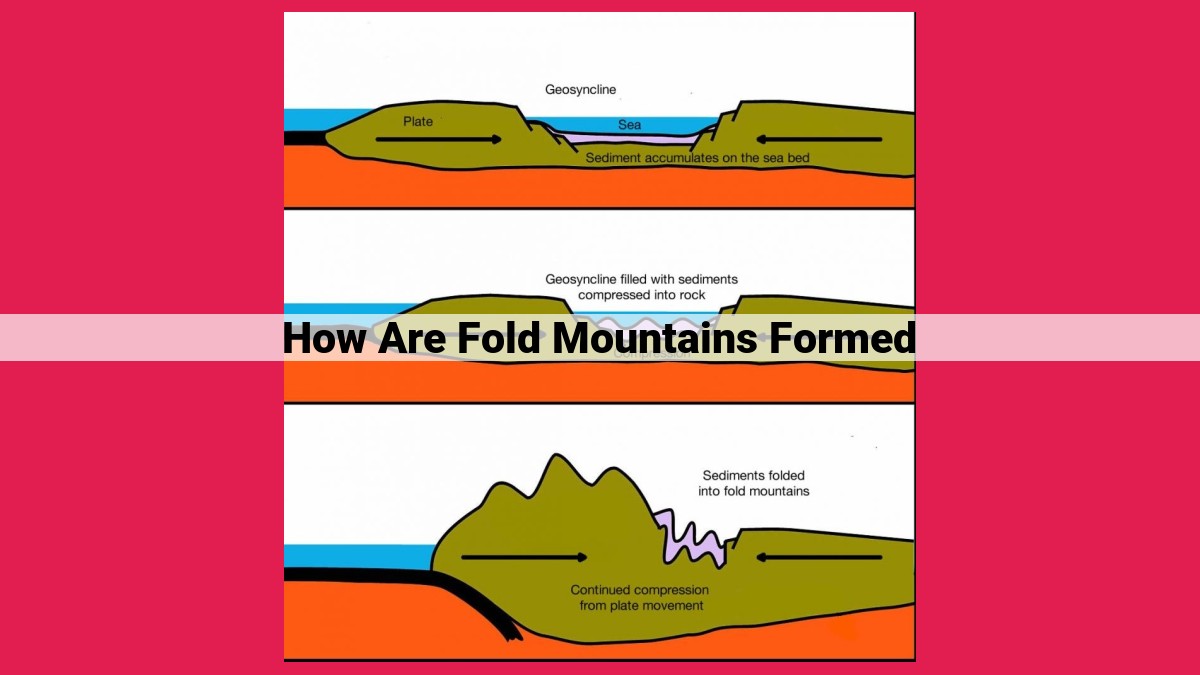Fold Mountains: Earth’s Majestic Tectonic Sculptures

Fold mountains arise from interactions between tectonic plates. When continental plates collide during orogeny, pressure forces the crust to fold and uplift, creating mountain ranges. Alternatively, plate subduction zones form oceanic trenches, causing rock deformation, folding, and uplift. This deformation can lead to folding, faulting, and metamorphism, transforming parent rocks into metamorphic rocks. These combined processes shape the Earth’s surface, resulting in the formation of majestic fold mountains.
The Majestic Marvels: Unraveling the Story of Fold Mountains
In the realm of nature’s wonders, fold mountains stand tall, majestic testaments to the relentless forces that shape our planet. They are natural cathedrals, their towering peaks reaching towards the heavens, each a symphony of geological processes. At their heart lies the intricate dance of tectonic plates, a ballet that has sculpted our Earth’s surface.
These mountains are born from the collision of Earth’s tectonic plates, continents colliding like colossal leviathans. As they converge, the Earth’s crust crumbles and buckles, driven by immense pressures. This cataclysmic event triggers orogeny, the process that gives birth to mighty mountain ranges.
The collision of continents is just one player in this geological drama. Subduction zones also take center stage, where one tectonic plate plunges beneath another. As the heavier plate descends, it melts and releases fluids that rise through the overlying plate, fueling volcanic activity. This volcanic activity further adds to the chaos, spewing molten rock onto the surface and contributing to mountain building.
Continental Collision and Orogeny
In the dynamic theater of Earth’s geology, plate tectonics plays a pivotal role in shaping our planet’s surface. One of nature’s grand spectacles is the formation of fold mountains, a testament to the immense forces at play beneath our feet.
When two continental plates collide, the Earth’s crust buckles like a crumpled piece of paper, creating vast mountainous regions. This titanic collision sends shockwaves through the crust, pushing rock layers upward and folding them into intricate formations. Over time, relentless pressure and heat metamorphose these rocks, transforming them into hardened and often crystalline forms.
The process of continental collision and orogeny is a testament to the Earth’s transformative power. As plates relentlessly converge, towering peaks emerge like celestial spires, forever altering the landscape. These majestic mountains serve as monuments to Earth’s dynamic history, a testament to the planet’s ceaseless reshaping and renewal.
Plate Subduction and Trench Formation: Nature’s Majestic Sculpting Process
Plate Subduction: A Tectonic Dance
Deep beneath the ocean’s surface, a dramatic dance unfolds between Earth’s tectonic plates. When one oceanic plate slides beneath another oceanic plate or a continental plate, it marks the commencement of plate subduction. This process plays a pivotal role in fold mountain formation.
Trench Formation: Oceanic Chasms
As the subducting plate plunges into the mantle, it creates an oceanic trench. These deep, narrow chasms can stretch hundreds of kilometers and plunge thousands of meters below sea level. The Mariana Trench, the deepest point on Earth, owes its existence to subduction.
Mountain Formation: A Rising Spectacle
The overriding plate above the subduction zone experiences a cascade of effects. As the subducting plate dives, it drags the overriding plate along with it. The overriding plate bends and folds, creating anticlines (upward folds) and synclines (downward folds). Over time, these folds can rise above sea level, forming towering fold mountains.
Earth’s Constant Transformation
Plate subduction and trench formation are dynamic processes. As plates collide, converge, and subduct, the Earth’s surface is constantly being shaped. These processes not only create magnificent mountain ranges but also influence the distribution of earthquakes, volcanoes, and mineral deposits.
Fold mountains stand as a testament to the power and complexity of Earth’s tectonic forces. Plate subduction and trench formation are integral parts of this symphony of geology, shaping our planet’s surface and fostering the emergence of some of nature’s most awe-inspiring landscapes.
Folding and Uplifting: The Earth’s Canvas of Mountains
As the tectonic plates dance across the Earth’s mantle, their colossal collision sets the stage for the birth of mountains. Within the crust, where once lay flat, sedimentary layers, an extraordinary metamorphosis unfolds.
Under immense pressure, the crust folds, like an accordion pressed between two giant forces. These folds, similar to the creases in a crumpled paper, shape the contours of the Earth’s surface, creating ridges and valleys that stretch across landscapes.
Accompanying the folding is a relentless uplift. The mighty shoulders of mountains rise towards the heavens as the crust is pushed upwards by the relentless forces below. This uplift, like an unseen hand, lifts the folded layers, carving out towering peaks and sculpting valleys deep into the land.
As the crust buckles and bends, it fractures, forming faults and joints. These fissures, like scars on the Earth’s surface, provide glimpses into the internal workings of the planet, revealing the intricate dynamics that shape its geological tapestry.
Metamorphism and the Transformation of Rocks
As the Earth’s crust undergoes immense pressure and heat during fold mountain formation, a transformative process called metamorphism takes center stage. Metamorphism literally translates to “change of form,” and it’s precisely what happens to rocks as they endure these extreme conditions.
Heat and pressure work their magic, causing rocks to undergo mineral recrystallization and chemical alterations. Original parent rocks – such as sandstone, limestone, and shale – are gradually transformed into metamorphic rocks with distinct characteristics.
For instance, sandstone, once composed of loose sand grains, recrystallizes under high temperatures and pressures to form quartzite, a hard and durable rock with interlocking quartz crystals. Similarly, limestone, composed of calcium carbonate, metamorphoses into marble, a crystalline and often colorful rock prized for its aesthetic appeal.
Metamorphic rocks provide valuable clues about the geological history of an area. Their mineral composition and textures reflect the specific conditions under which they formed, offering insights into the temperature, pressure, and stress that shaped the fold mountain range. By studying metamorphic rocks, geologists gain a better understanding of the processes that have shaped our planet’s surface over eons.